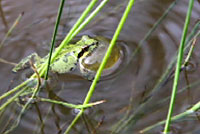
A Guide to California's
Reptiles and Amphibians
Sounds of
Sierran Treefrog - Pseudacris sierra
(Jameson, Mackey, and Richmond, 1966)
(= Pacific Chorus Frog, = Pacific Treefrog. SeeAlternate Names)

Male calling at night

Male being picked up across its back extending its throat pouch and producing the release call

Calling male with throat sack partially extended.
Sierran Treefrog
Pictures and Information.
|
Male frogs and toads sometimes make a variety of sounds. These calls can have different functions. Advertisement Calls The advertisement call is the most well-known call of a frog or toad. It is made by a male during the breeding season to establish his territory and repel rival males and to attract females as potential mates. Males usually make the call in or near bodies of water near areas that are attractive to a female as a good place to lay her eggs. Advertisement calls can be heard during the evening and at night, and often during daylight at the peak of the breeding season. Sometimes an advertisement call will be heard outside of the breeding season and away from water. The reason for this is not understood. Each species has its own unique advertisement call. This is necessary to differentiate them when there is more than one species calling. The evolution of this specific male advertisement call and its recognition by females is considered to be an important isolating mechanism in the evolution of a species. The Sierran Treefrog produces two different kinds of very loud advertisement calls: a two-part, or diphasic call, typically described as rib-it, or krek-ek, with the last syllable rising in inflection, and a one-part, or monophasic call, also called the enhanced mate attraction call. The call of the Baja California Treefrog is known throughout the world through its wide use as a nighttime background sound in many Hollywood movies, even those which are set in areas well outside the range of this frog. The call of the Baja California Treefrog is identical to that of the Sierran Treefrog and the Pacific Treefrog, and it is possible that the calls of all of these species were also used as movie sound effects. | |
Diphasic (two-part) Call This call is produced during the day and at night, often in large choruses. |
|
A large nocturnal chorus like this sounds like a loud high-pitched buzz making it difficult to hear the individual calls. |
|
with a heavy wind sound in the background. |
|
| Waveform and Sonogram | |
 |
|
The image above is a visual representation of this call. Click on it to see a larger image. Click here for information about how to read the waveform and sonogram images. |
|
Monophasic (one-part) (enhanced) Call This call is produced during the day and at night. It is produced at a high rate when a male is approached by a female, and he continues to produce it until he has amplexed the female. |
|
Trilled Encounter Call The trilled encounter call is a raspy trilled sound. It is an aggressive signal aimed at other males and is used to establish spacing between them at the calling site during a breeding chorus. The encounter call is typically heard during the beginning of the chorus when territories are being established and then later when a male intrudes on the territory of another male either physically or with very loud calling. |
|
| Land Call The land call is a prolonged one-note kr-r-r-ek sound. Land calls can be heard during the day, often in wooded areas away from water. I have heard frogs produce this call while they were sitting high on a tree branch as well as when they were on the ground, usually hidden in dense vegetation. The call is sometimes referred to as the "Fall awakening call" and it does appear to be made mostly during Fall when the rains are beginning and the frogs are coming out of their summer slumber. |
|
| Daytime Calls During daylight, frogs often make a variety of calls which probably help them to warm up and establish a territory before they begin the full chorus. A group of frogs calling during daylight, can sound much different than a full night chorus (or day chorus during the peak of the breeding season.) Typically there are fewer frogs making weaker calls and they will start and stop, leaving long stretches of silence. Sometimes they make what sounds like a series of land calls, other times they make the faster one-part enhanced call. Sometimes they make the encounter call. When a lot of frogs start calling, they will then start making the two-parted call. And sometimes one or two frogs will simply make the two-part call repeated at longer intervals than in a full chorus. |
|
Release Call The release call is made by a frog when another male frog attempts to clasp its back in amplexus. A frog will also produce this call when it is grabbed across the back by a human, and probably also when it is grabbed by other types of predators. (See picture above left.) |
|
| Short Videos | |
You can listen to more recordings of Sierran (Pacific) Treefrogs on this cd: Carlos Davidson - Frog and Toad Calls of the Pacific Coast  and on the cd that comes with this book: Lang Elliott, Carl Gerhardt, and Carlos Davidson - The Frogs and Toads of North America - Houghton Mifflin Harcourt.  |
|
Return to the Top
© 2000 -




